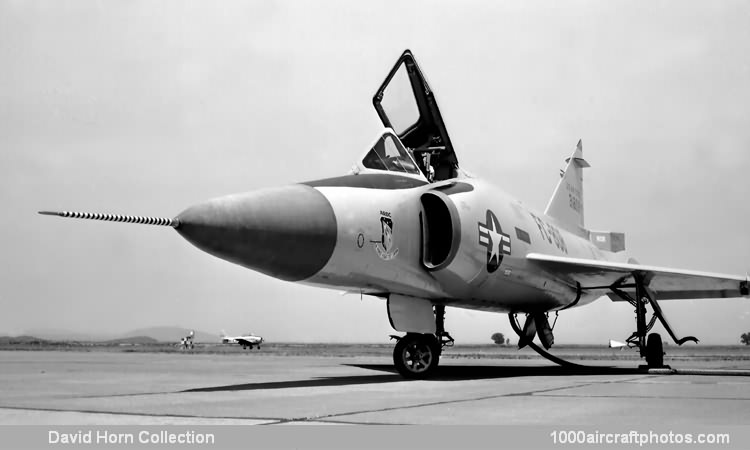04/30/2010. Remarks by Johan Visschedijk: "Deliveries of the F-102 to the USAF, beginning in June 1955, marked the introduction into service of the first delta-wing aircraft the Air Force had accepted. Its design, begun in 1950, was closely related to that of the experimental XF-92A, which Convair had built in 1948 to provide data for the proposed F-92 (Model 7) Mach 1.5 fighter designed in consultation with Dr. Alexander Lippisch, who had done much research on delta wings in Germany. The XF-92A (Model 7-002) was the first powered delta-wing aircraft flown, and the YF-102 (Model 8-80) with which Convair won the 1950 design contest, was basically the XF-92A scaled up by 1.22:1.
The first YF-102 (52-7994) flew at Edwards AFB on October 24,1953, and the second on January 11, 1954, both being powered by the Pratt & Whitney J57-P-11 turbojet rated at 10,000 lb (4,536 kg) st dry and 15,000 lb (6,804 kg) st with afterburning. These aircraft were found deficient in performance, and while a further eight YF-102s (Model 8-82) were being built to the same standard, Convair embarked on a major investigation and redesign program. The latter occupied only 117 days, and on December 20, 1954, the first YF-102A (Model 8-90) made its first flight.
The most prominent new feature was a longer fuselage with a pinched or 'coke-bottle' waist-the first application of 'area rule' developed at NACA by Richard Whitcomb. The wing leading edge was cambered and the tips were given wash-in. The J57-P-23 turbojet was installed, rated at 11,700 lb (5,307 kg) st dry and 17,200 lb (7,802 kg) st with afterburning, and the cockpit canopy redesigned.
From the outset, the F-102 had been designed as a missile carrier, and it was in fact the first USAF fighter to become operational armed only with guided missiles and unguided rockets. The WS201A weapon system included the Convair F-102 and the Hughes MG-3 fire-control systems
and Falcon armament, and was the first Air Defense weapon system to include a piloted aircraft.
The first of four YF-102As achieved supersonic speed on its second flight, and production of the similar F-102A (Model 8-10) proceeded. Between 1953 and 1957, five production contracts were awarded for a total of 875 F-102As, the first going into squadron service in mid-1956 and the last being completed in April 1958. In 1957, Convair began a modernization program for early F-102As to bring them up to the latest standard, including a larger tail, MG-10 in place of MG-3 fire control system, fittings for wing drop tanks and provision for 2.75 in (70 mm) in place of 2.0 in (51 mm) rockets. A subsequent program added an infra-red sighting system and deleted the internal rocket armament.
More than 25 Air Defense Command squadrons used the F-102A, and the type also served in Alaska until 1969 and with USAFE squadrons in Europe until 1970, by that time enough aircraft had been transferred to the Air National Guard to equip 13 ANG squadrons, while 60 F-102As were supplied to the Greek (20) and Turkish (40) air forces.
To serve as a combat trainer, the Air Force also purchased 63 TF-102As (Weapon System WS201L) which were similar to the F-102A but had a wider front fuselage seating two side-by-side. Full operational equipment and armament was retained. The first TF-102A (Convair Model 8-12) flew on November 8, 1955."
